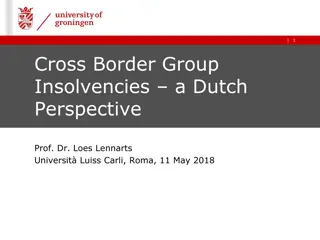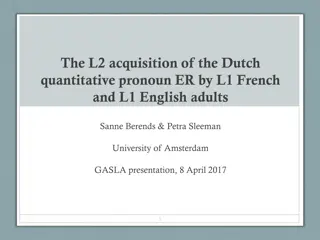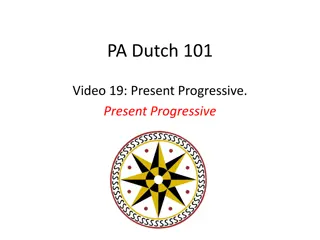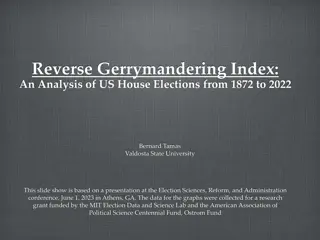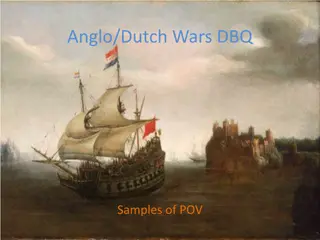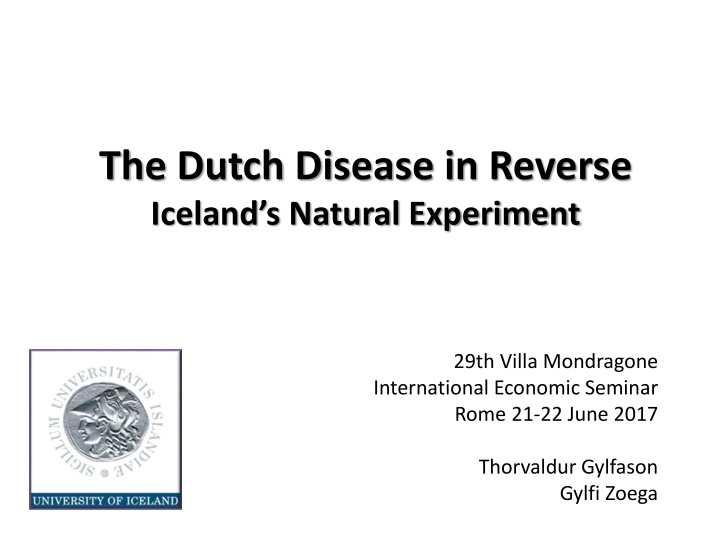
Reverse Dutch Disease in Iceland: Economic Impacts and Recovery
Explore the reverse Dutch disease phenomenon in Iceland following the 2008 financial collapse, where a currency depreciation led to economic recovery and a tourism boom. Learn about the adverse effects of natural resource abundance on the economy, relevant literature on the topic, and parallels with foreign credit inflows.
Download Presentation

Please find below an Image/Link to download the presentation.
The content on the website is provided AS IS for your information and personal use only. It may not be sold, licensed, or shared on other websites without obtaining consent from the author. If you encounter any issues during the download, it is possible that the publisher has removed the file from their server.
You are allowed to download the files provided on this website for personal or commercial use, subject to the condition that they are used lawfully. All files are the property of their respective owners.
The content on the website is provided AS IS for your information and personal use only. It may not be sold, licensed, or shared on other websites without obtaining consent from the author.
E N D
Presentation Transcript
The Dutch Disease in Reverse Iceland s Natural Experiment 29th Villa Mondragone International Economic Seminar Rome 21-22 June 2017 Thorvaldur Gylfason Gylfi Zoega
Key points Abundant natural resources brought Iceland a systemically overvalued currency, with adverse effects on manufacturing and services During 2003-2008 another national treasure, the sovereign s AAA rating, was used to attract foreign capital, elevating the real exchange rate even further The financial collapse in 2008 left Iceland with a large foreign debt without the possibility of rollovers in foreign capital markets The currency plunged, producing a bout of the Dutch disease in reverse as witnessed, in particular, by a massive expansion of tourism after the crash
Key points Insofar as the trouble with abundant natural resources and reputation mining has to do with the appreciation of the currency, the depreciation resulting from a financial crash can be viewed as a case of the Dutch disease in reverse Just as currency appreciation weakens the current account, a massive depreciation after a financial crash stifles imports and strengthens exports, paving the way toward economic recovery
Literature Recent literature highlights several channels through which natural resource abundance, if not well managed, may retard economic growth Rent seeking Dutch disease Poor governance Political or ethnic conflict Corruption Autocracy Excessive borrowing Low levels of education
Literature Our 1999 model showed how a large and volatile primary sector would adversely affect the output of tradable goods by increasing real wages and the real exchange rate, lowering the relative price of tradable goods and hampering investment If learning-by-doing occurs mostly in the secondary export sector and not in the primary sector, we also showed that natural resource booms are likely to hamper growth by discouraging employment and investment
Parallels Inflows of foreign credit can exert a similar manna-from-heaven effect on its recipients as resource windfalls and foreign aid not least if the borrowing nation behaves as if there is no tomorrow and bankers revel in their role as rentiers In some cases, resource windfalls, foreign aid and rapid capital inflows may invite plunder with royal families, clerics, generals, politicians and bankers sitting in the driver s seat
GNI per capita 1990-2015 (Current international dollars, ppp) Denmark and Iceland Greece, Iceland, Ireland, Latvia 60000 60000 Greece Iceland Ireland Latvia Denmark 50000 50000 Iceland 40000 40000 30000 30000 20000 20000 10000 10000 0 0 Rapid recovery accompanied by quick return to full employment amid labor unrest Source: World Bank, World Development Indicators.
Model Primary output is stochastic and follows a Brownian motion subject to random productivity shocks and is independent of the real exchange rate: ???= ??? + ??? dW represents the increment of a Wiener process ?? = ?? ?? , having a zero mean and a unit SD The drift term ??? reflects growth in primary output while the stochastic term represents the vicissitudes of, e.g., commodity prices that make primary output rise or fall at random, creating uncertainty about output in the primary sector
Model Secondary output is deterministic ??= ?0+ ?1??? ? ??= ?0 ?1??? ? ?? ??? ? =?0 ?0+ ? ?1+ ?1 ?1+ ?1 ? ? ???? ? = ?1+ ?1?? ?1+ ?1??
Model 2 ? +1 ? ? ?? = ??? ??? ?1+ ?1 2 ?1+ ?1 ?1+ ?1 ? The drift term, with < 0 denoting appreciation a fall in the relative price of tradable goods signals the Dutch disease The volatility of the real exchange rate via the stochastic term may be no less important in its effect on investment for other export industries and import-competing industries
Model ??? ? 1 ?? ? 1 ? 1 ?? 1 ?? = ? ? 1 ? 2 ? 1 ?? ? 1 +1 ? 2? 1 1 ? ? 1 ?? 1 ?? ? ?? 2 1 ? ?1+ ?1 ? 1 ? 1 ?? ? ? 1 ?? 1 ?? 1 ?? ?? ?1+?1 ???= ?( , K, R, w)dt + B( , K, R, w)dW
Model Primary output is stochastic, and so is, therefore, also the real exchange rate and secondary output Employment and output in secondary sector depend on , and hence on primary output and external debt as well as primary-sector wages A primary-sector boom has an immediate adverse effect on secondary output by reducing (i.e., by making the currency appreciate), a key aspect of the Dutch disease
Upshot Real exchange rate depends on current and lagged shocks to primary output and capital flows Secondary output depends on Consumption of tradable goods also depends on So, through , primary output shocks and volatility, like capital flows, impact secondary output, employment and consumption
VAR model ? ??= ?0+ ???? ?+ ?? ?=1 = (?,??, ?, ?? ?? E = real exchange rate (i.e., ) CA = current account (% of GDP) T = change in tourists (% of population) NP = change in non-primary exports (% of total exports)
MLE estimation results for VAR(2) Increase of E from 1 to 1.1 will improve CA by 3.2% next year T 8.13 NP 8.40 1960-2012 Log(E) CA Log(E-1) Log(E-2) CA-1 CA-2 T-1 T-2 NP-1 NP-2 R2 1.00* 32.25* -0.20 -29.12* 27.35* -10.80 -0.00 0.00 0.48* 0.14 -0.53* 0.21 -0.22 0.16 -0.00 -0.12 0.33* 0.13 0.00 0.00 0.10 -0.40 -0.59* 0.40 -0.10 0.04 0.01 -0.01 -0.42 -0.24 0.64 0.65 0.61 0.25 t-values not shown; * denotes statistical significance at the 5% level.
VAR Results: Impulse responses to currency depreciation Response of LOG(E) to LOG(E) Response of Log(E) to Log(E) Response of CA to LOG(E) Response of CA to Log(E) .12 6 .08 4 .04 2 .00 0 -.04 -2 -.08 -4 1 2 3 4 5 6 7 8 9 10 1 2 3 4 5 6 7 8 9 10 Response of D(NP) to LOG(E) Response of NP to Log(E) Response of D(T) to LOG(E) Response of T to Log(E) 6 4 4 3 2 2 0 1 -2 0 -4 -1 -6 -2 1 2 3 4 5 6 7 8 9 10 1 2 3 4 5 6 7 8 9 10
Discussion Capital inflows resemble natural resource windfalls in that both events flood the recipient country with easy money, triggering similar reactions among the natives General euphoria Real appreciation of the currency (Dutch disease) Reckless public policies in the belief that anything goes Rent seeking, even plunder Large capital outflows can be viewed as the Dutch disease in reverse, triggering an economic downturn and real depreciation of the currency
Discussion Iceland experience underlines essential complementarity of elasticities and asset market approaches to BOP and exchange rates Real depreciation boosts exports and reduces imports In Iceland, no evidence of elasticity pessimism Kr na rate rose sharply due to large capital inflows before the crash -- nothing to do with trade flows Thereafter, kr na collapsed as capital flows were reversed, and tradables, especially tourism, became viable at last Current account deficit turned quickly to surplus



